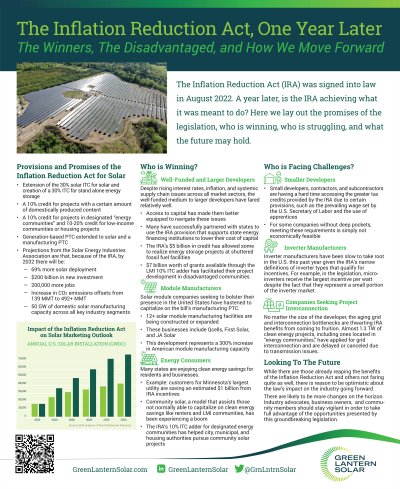Back

Regulatory Innovation and Policy Drivers
The Inflation Reduction Act, One Year Later – The Winners, The Disadvantaged and How We Move Forward
Tuesday, September 12, 2023
4:30 PM - 5:30 PM PDT
Location: Poster Area, Booth #11024, Level 1, Venetian Expo Hall


Scott Buckley, n/a
President
Green Lantern Solar, United States
Poster Presenter(s)
Description and Background: When the Inflation Reduction Act was signed into law in August 2022, there was a lot of excitement in the renewable energy industry about opening up pathways for growth, significant cost savings on projects and increasing reliance on wind, solar and other renewables over fossil fuels. The IRA was supposed to create clean energy jobs, reduce pollution in underserved and oft-forgotten communities, and cut carbon emissions by 40 percent by 2030.
A year later, is the IRA achieving what it was meant to do?
In 2022, the good intentions of the law had to contend with rising interest rates, inflation and supply chain issues. Those three factors alone created obstacles in the solar industry, altering how projects were financed, bought and sold and affecting completion timelines. Developers flush with capital and access to more had an easier time navigating these issues, but the IRA inadvertently created hardships for the little guy, the shops that did not have as many funds or resources to acquire them. Small developers, contractors and sub-contractors – vital to achieving the country’s energy and climate goals – have a harder time meeting provisions in the IRA that would provide greater tax credits, such as the prevailing wage set by U.S. Secretary of Labor and the use of apprentices for example.
In this session, Scott Buckley, president of Green Lantern Solar, which was founded in 2011 and provides financing and development for the deployment of commercial, solar + storage, and community solar projects, will lay out who the winners and losers are a year after the IRA became law. He will also share what changes Green Lantern Solar went through since August 2022.
A year later, is the IRA achieving what it was meant to do?
In 2022, the good intentions of the law had to contend with rising interest rates, inflation and supply chain issues. Those three factors alone created obstacles in the solar industry, altering how projects were financed, bought and sold and affecting completion timelines. Developers flush with capital and access to more had an easier time navigating these issues, but the IRA inadvertently created hardships for the little guy, the shops that did not have as many funds or resources to acquire them. Small developers, contractors and sub-contractors – vital to achieving the country’s energy and climate goals – have a harder time meeting provisions in the IRA that would provide greater tax credits, such as the prevailing wage set by U.S. Secretary of Labor and the use of apprentices for example.
In this session, Scott Buckley, president of Green Lantern Solar, which was founded in 2011 and provides financing and development for the deployment of commercial, solar + storage, and community solar projects, will lay out who the winners and losers are a year after the IRA became law. He will also share what changes Green Lantern Solar went through since August 2022.
